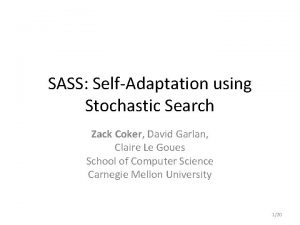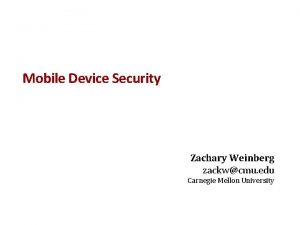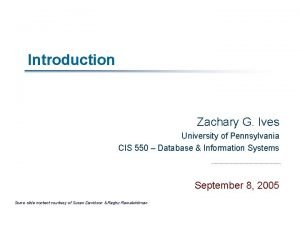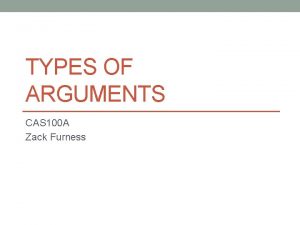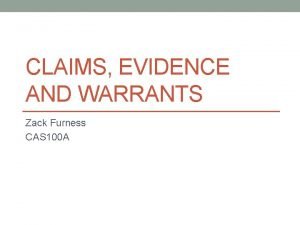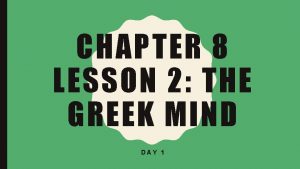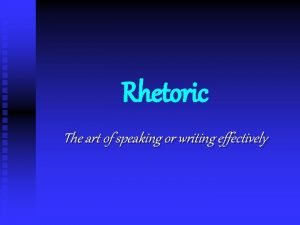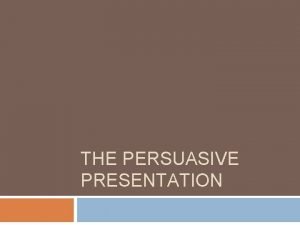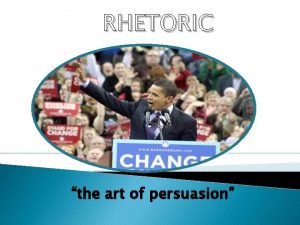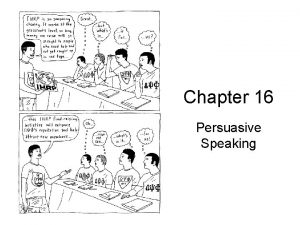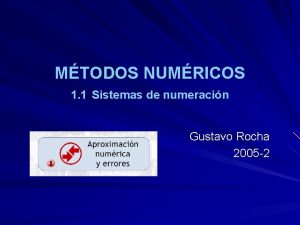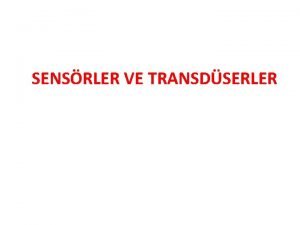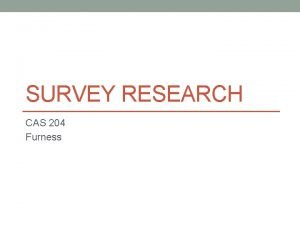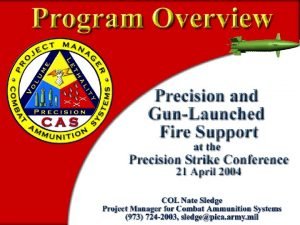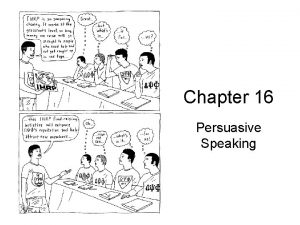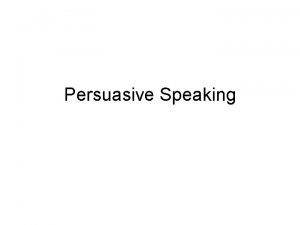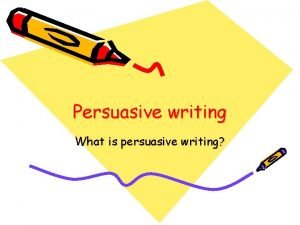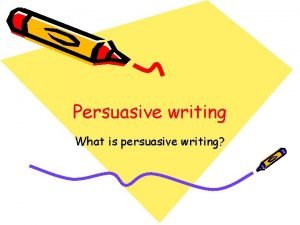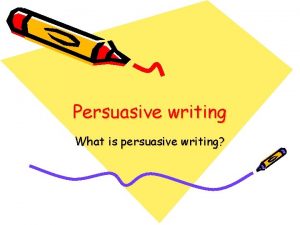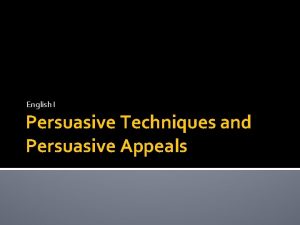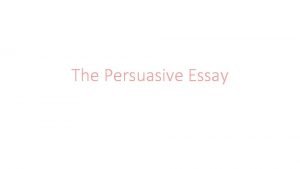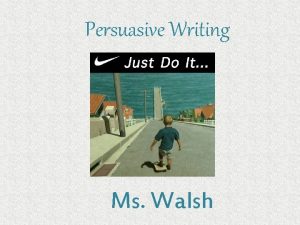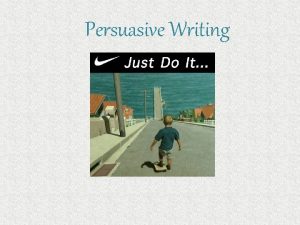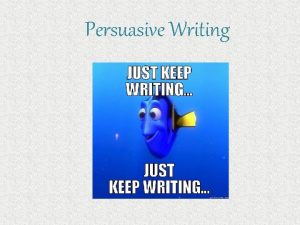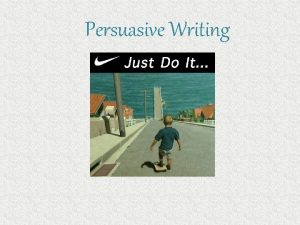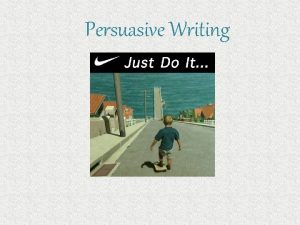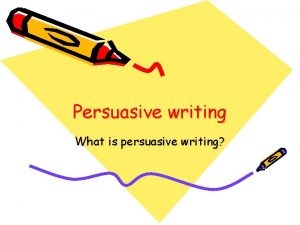Persuasive Speaking Reasoning CAS 100 SP 17 Zack




















































- Slides: 52

Persuasive Speaking & Reasoning CAS 100 – SP 17 Zack Furness

Persuasive Speaking = The goal is to influence audience members’ Attitudes; Beliefs; Values; Actions.

Focus on Motivation = Use information from audience analysis. Make the message personally relevant to listeners. = Demonstrate the benefit to the audience. = Establish your credibility. = Set modest goals.

Focus on Motivation (cont. ) = Demonstrate how attitudes can prevent satisfaction. Encourage receptivity to change. = Greater success comes when the audience holds a similar position.

Balance Reason and Emotion = Argument Position with support for/against something = Logos (appealing to reason and logic) Critical when asking listeners to Reach conclusions regarding complicated issues Take a specific action

Balance Reason and Emotion (cont. ) = Pathos (emotions) Methods of appealing to pathos: Using vivid imagery Telling compelling stories Using repetition and parallelism

Stress Your Credibility = Ethos Moral character Modern term is speaker credibility = Audience must view you as credible Increases their level of receptivity

Establishing Credibility = Emphasize your grasp of the topic. = Demonstrate trustworthiness. Reveal your true speech goals. Establish common ground. Express genuine interest in audience’s welfare. = Strive for a dynamic delivery.

Target Listeners’ Needs = Maslow’s hierarchy of needs Lower levels must be met first Higher levels considered unimportant until then

Maslow’s Hierarchy of Needs

Target Listeners’ Needs (cont. ) =Physiological needs Having food, water, air, and safety Plan for and accommodate listeners’ needs Appeal to safety benefits

Target Listeners’ Needs (cont. ) =Social needs Finding acceptance, having meaningful relationships Appeal to social benefits =Self-esteem needs Feeling good about ourselves Appeal to emotional benefits

Target Listeners’ Needs (cont. ) =Self-actualization needs Achieving goals, reaching our potential Appeal to need to fulfill potential

Encourage Mental Engagement =Elaboration likelihood model of persuasion Central processing Listeners Are motivated and thinking critically; Seriously consider what your message means to them; Are most likely to act on your message.

Encourage Mental Engagement (cont. ) Peripheral Listeners pay little attention; consider your message processing Irrelevant; Too complex to follow; Just plain unimportant. They might support you for superficial reasons.

Encourage Mental Engagement (cont. ) =Link arguments to listeners’ practical concerns. =Use the appropriate level of understanding. =Demonstrate common bonds. =Stress your credibility.

Construct Sound Arguments =Three elements to an argument: Claim or proposition (states your conclusion) Based on evidence Evidence (substantiates the claim) Warrant (provides reasons evidence is valid)

Identify the Nature of Your Claims = Claim of fact Whether something is true or will happen = Claim of value Addresses issues of judgment = Claim of policy Recommends a specific course of action

Speeches About Questions of Fact = Broadly speaking, these deal with the truth or falsity of an assertion. = Engage questions of interpretation, definition, existence, and action. = Examples: To persuade my audience that Syria meets the political-science definition of a “failed state. ” To persuade my audience that current accounts of the history of philosophy have overlooked the role of women philosophers. To persuade my audience that hip-hop owes a debt to Black Consciousness Movement poets of the late 1960’s.

Speeches About Questions of Value = Deals with questions about the worth, rightness, morality, and so forth of an idea or action. = Engage questions about opinion, moral judgment, or comparative worth. = Examples: To persuade my audience that the death penalty is morally wrong. To persuade my audience that baseball is better than football. To persuade my audience that voting is a waste of time.

Speeches About Questions of Policy = Deals with questions about whether a specific course of action should or should not be taken. Type #1: Passive Agreement with a policy position To persuade my audience that the US should pay reparations for its involvement in human rights abuses in Central America in the 1970 s To persuade my audience to see LGBT rights as a human rights issue. To persuade my audience to support the Palestinian bid for statehood. Type #2: Calls for Immediate Action To persuade my audience to boycott Penn State Football To persuade my audience to go vegetarian To persuade my audience not to sign a petition banning pepper spray on campus.

Fact, Value, or Policy The same topic can have a fact, value, or policy focus = Fact: To persuade my audience that long-term 23 hour solitary confinement in US prisons constitutes cruel and unusual punishment. = Value: To persuade my audience that long-term 23 hour solitary confinement in US prisons is morally and legally wrong = Policy: Passive Agreement: To persuade my audience that the policy of solitary confinement should be changed. Immediate Action: To persuade my audience to write to their representatives demanding a policy change.

Basic Issues of Policy Speeches Need – Is there a serious problem or need that requires a change from current policy? Plan – If there is a problem with current policy, does the speaker have a plan to solve the problem? Practicality – Will the speaker’s plan solve the problem? Will the speaker’s plan create new and more serious problems?

Speeches of Policy – Organization Problem-solution order Main point I: Documents the existence of a problem. Main point II: Presents a solution to the problem. Example: Specific Purpose: To persuade my audience that the use of antibacterial chemicals in household products is creating health and environmental problems. Main Point I. The use of antibacterial chemicals in household products is a serious problem. Main Point II. Solving these problems requires a combination of government and consumer action.

Speeches of Policy – Organization Problem-cause-solution order Main point I: Documents the existence of a problem. Main point II: Analyzes the causes of the problem. Main point III: Presents a solution to the problem. Example: Specific Purpose: To persuade my audience that the age for full motor-vehicle driving privileges should be raised to 18. Main Point I. The number of accidents and death involving teenage drivers is a serious national problem. Main Point II. There are four main causes of the problem. Main Point III. We can help solve these problems by raising the age for full driving privileges.

Speeches of Policy – Organization Comparative Advantages Order Each main point explains why a speaker's solution to a problem is preferable to other potential solutions. Example: = Specific Purpose: To persuade my audience that the U. S. space program should put greater priority on unstaffed scientific missions. = Main Point I. Unstaffed scientific missions are less costly than staffed space flights. = Main Point II. Unstaffed scientific missions provide more practical benefits than staffed space flights.

Use Convincing Evidence = External evidence Examples, narratives, testimony, facts, statistics = Audience’s preexisting knowledge/opinions Reaffirm listeners’ own attitudes, beliefs, values = Speaker expertise Offer in conjunction with other evidence

Address the Other Side of the Argument = One-sided message Does not mention opposing claims = Two-sided message Mentions opposing points of view Sometimes refutes them Generally more persuasive

Address the Other Side of the Argument (cont. ) = Ignoring opposing arguments might damage your credibility. = You don’t need to acknowledge/refute counterarguments. = Raise/refute the most important counterclaims. all

Use Effective Reasoning = Reasoning Drawing conclusions from evidence = Arguments using deductive reasoning Begin with a general principle/case; Offer a specific example; Lead to the speaker’s conclusion.

Use Effective Reasoning (cont. ) = Inductive reasoning Moves from specific case to general conclusion Speaker’s conclusion appears to be true. Not necessarily true Arguments can be strong or weak.

Use Effective Reasoning (cont. ) = Reasoning by analogy Common form of inductive reasoning Speaker compares two similar cases Implies that what is true in one true in the other = Causal reasoning Claims one event/circumstance causes another is

Avoid Fallacies in Reasoning = Logical fallacy False/erroneous statements Deceptive reasoning Must be aware of them to Avoid making them yourself; Identify them in others’ speeches.

Types of Logical Fallacies = Begging the question Circular reasoning - conclusion is assumed in one of the premises Example: “Paranormal activity is real because I have experienced what can only be described as paranormal activity. ” = Bandwagoning Basing an argument on general opinion Example: “The President must be correct in his approach to domestic policy; after all, polls show that 60 percent of the people support him. ”

Types of Logical Fallacies (cont. ) = Either-or fallacy Presents only two possible alternatives May be many additional alternatives Example: “The government can either create jobs or reduce services for the poor, but we can’t have both. ” = Ad hominem argument Targets a person instead of the issue Incites audience’s dislike of that person Example: “He has a number of solid proposals, but we should remember that he is not a god fearing man. ”

Types of Logical Fallacies (cont. ) = Red herring Relies on irrelevant premises Example: “Why should we worry about endangered animal species when thousands of people are killed in car accidents each year? ” = Hasty generalization Bases general conclusion on isolated instance Example: “Last year alone three members of our state legislature were convicted of corruption. We can conclude, then, that all of our state‘s politicians are corrupt. ” = Non sequitur (“does not follow”) Reasoning and conclusion are unconnected

Types of Logical Fallacies (cont. ) = Slippery slope Faulty assumption that one case will lead to a series of events or actions Example: “If we pass laws prohibiting assault rifles then the government will eventually pass laws prohibiting all firearms. ” = Invalid Analogy: An analogy in which the two cases being compared are not essentially alike. Example: “Of course Jan can prepare great Italian food; his Chinese cooking is fabulous. ”

Types of Logical Fallacies (cont. ) = False Cause Faulty assumption that because one event follows another, the first event is the cause of the second Example: “I’m sure the stock market will rise this year. It usually goes up when the American League wins the World Series. ” = Appeal to tradition Suggests agreement because it is the way something has always been done Example: “Our grandparents did it this way and we should as well. ”

Address Culture = Core values Shared by listeners of a culture Clashing appeals are usually unsuccessful. = Cultural norms Group’s rules for behavior Arguing against them usually fails.

Address Culture (cont. ) = Cultural premises Specific values about identity and relationships Difficult to challenge deeply-held premises

Address Culture (cont. ) = Emotions Ego-focused (anger, happiness, frustration) Other-focused (empathy, shame) Appeal to emotions in listeners’ comfort zone. Avoid undue emphasis on uncomfortable emotions.

Strengthen Your Case with Organization = Problem-solution pattern Used when discussing claims of policy Two-point pattern I. Problem (define what it is) II. Solution (offer method for overcoming problem)

Strengthen Your Case with Organization (cont. ) = Problem-cause-solution pattern I. Nature of the problem II. Reasons for the problem III. Proposed solution

Strengthen Your Case with Organization (cont. ) = Problem-cause-solution-feasibility pattern I. Nature of the problem II. Reasons for the problem III. Proposed solution IV. Evidence of solution’s feasibility

Strengthen Your Case with Organization (cont. ) = Monroe’s motivated sequence I. Attention Addresses listeners’ core concerns II. Need Isolates the issue to be addressed

Strengthen Your Case with Organization (cont. ) III. Satisfaction Identifies IV. Visualization Provides the solution a vision of anticipated outcomes V. Action Asks audience members to act

Strengthen Your Case with Organization (cont. ) = Comparative advantage pattern Used to show your proposal’s superiority Best when audience agrees solution is needed Make sure to identify familiar alternatives

Strengthen Your Case with Organization (cont. ) = Refutation pattern I. State the opposing position II. Describe why opposing claim is faulty III. Offer arguments/evidence for your position IV. Contrast your position with opposing claim

Identify the Disposition of the Audience = Hostile audience Stress areas of agreement. Address opposing views. Don’t expect major change in attitudes. Wait until the end to ask the audience to act. Reason inductively. Consider the refutation pattern.

Identify the Disposition of the Audience (cont. ) = Critical and conflicted audience Present strong arguments and evidence. Address opposing views. Consider the refutation pattern.

Identify the Disposition of the Audience (cont. ) = Sympathetic audience Use motivational stories and emotional appeals. Reinforce positive attitudes. Stress commonality with listeners. Clearly tell listeners what you want them to do. Consider the narrative (storytelling) pattern.

Identify the Disposition of the Audience (cont. ) = Uninformed, less-educated, or apathetic audience Focus on capturing their attention. Stress personal credibility and likeability. Stress the topic’s relevance to listeners.
 100 100 100 100 100
100 100 100 100 100 Penn state cas 100 a b c
Penn state cas 100 a b c Bill zack
Bill zack Perspectometer
Perspectometer Mape-k
Mape-k Zack weinberg cmu
Zack weinberg cmu Zachary g. ives
Zachary g. ives Zack wolf
Zack wolf Zach olson md
Zach olson md Furness definition
Furness definition Evidence and claim examples
Evidence and claim examples Chapter 8 lesson 2 the greek mind
Chapter 8 lesson 2 the greek mind Inductive reasoning vs deductive reasoning
Inductive reasoning vs deductive reasoning Patterns and inductive reasoning
Patterns and inductive reasoning Inductive and deductive reasoning
Inductive and deductive reasoning Example of inductive reasoning
Example of inductive reasoning What is deductive reasoning
What is deductive reasoning Deductive method
Deductive method Every quiz has been easy. therefore the quiz will be easy
Every quiz has been easy. therefore the quiz will be easy The art of speaking or writing effectively.
The art of speaking or writing effectively. Persuasive presentation meaning
Persuasive presentation meaning Rhetoric: the art of persuasive writing and public speaking
Rhetoric: the art of persuasive writing and public speaking Persuasive speaking definition
Persuasive speaking definition Value persuasive speech
Value persuasive speech 100 + 100 = 200
100 + 100 = 200 70 in yüzde 40'ı kaçtır
70 in yüzde 40'ı kaçtır 200+200+300+300
200+200+300+300 1453-1337
1453-1337 1000 en romano
1000 en romano 200+200+100+100
200+200+100+100 100+100=200
100+100=200 C/100=f-32/180=k-273/100
C/100=f-32/180=k-273/100 200 + 200 + 300
200 + 200 + 300 Box plot gcse
Box plot gcse What's 100 + 100
What's 100 + 100 Big data on bare metal
Big data on bare metal Malloc lab 100/100
Malloc lab 100/100 Etermer
Etermer Cas romero
Cas romero Místní čas příklady
Místní čas příklady My hand ritsel notas
My hand ritsel notas Advantages and disadvantages of sample survey
Advantages and disadvantages of sample survey Excalibur pgm
Excalibur pgm Audit evidence for fixed assets
Audit evidence for fixed assets Ropmo
Ropmo Cas-croucher funding scheme for joint laboratories
Cas-croucher funding scheme for joint laboratories Ias cas tas gs
Ias cas tas gs Cass calarasi
Cass calarasi Trpný rod aj
Trpný rod aj Raisonnement et démarche clinique infirmière exemple
Raisonnement et démarche clinique infirmière exemple časová pásma příklady
časová pásma příklady Cas bcu
Cas bcu Cas treatment approaches
Cas treatment approaches




